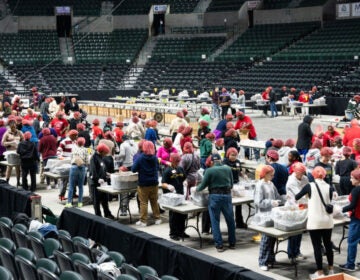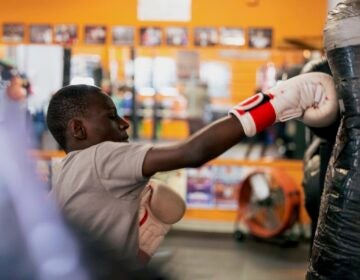It’s the 120th Christmas Bird Count! Head to Trenton to join the historic citizen science project
Now in its 120th year, the Audubon Society’s annual Christmas Bird Count is one of the oldest citizen science projects in the United States.

Dale Thayer of British Columbia, Canada, left, and Craig Peyton, of Phoenix, look for birds at the Boyce Thompson Arboretum in Superior, Ariz. in this Jan. 4, 2007. (AP Photo/East Valley Tribune, Toru Kawana)
A massive bird census is underway across the Philadelphia region.
Now in its 120th year, the Christmas Bird Count is one of the oldest citizen science projects in the United States, which helps provide an early winter snapshot of bird populations and migration patterns. (The annual census is a much safer tradition for the beaked travelers. Before the Audubon Society’s Frank Chapman came up with the idea in 1900, the Christmas holiday tradition was to hunt birds.)
In New Jersey, bird watchers of different skill levels can go to Trenton’s Abbott Marshlands on Saturday to help identify some of the feathered travelers.
Brad Merritt is helping to coordinate the Trenton event, and has taken part in the annual winter census for the past 40 years in an attempt to get more people into birdwatching.
“I love to see people, the wonderment in their eyes, when they see an unusual bird for the first time and they’re like, ‘Wow, I didn’t even know they were around here,’” said Merritt, a trained ornithologist, or someone who studies birds.
Merritt recruits census volunteers year-round through bird-watching “field trips” he runs on weekends through the Washington Crossing Audubon Society.
He also makes sure newbies aren’t overwhelmed during the count by placing them in groups with experienced volunteers and ornithologists.
“I’ve seen so many people never step out to look at birds, go out and then get hooked. They’re amazed by what is out there,” he said, adding most people just need a little help getting started.
When the count ends, Merritt will often organize a casual get together with food where volunteers share what they saw in the field.
In 2012, the Audubon Society scrapped registration fees for census volunteers, which Merritt thinks has helped keep participation numbers steady. In Trenton, the number of volunteers has hovered around 40.
Unlike the U.S. Census, volunteers are not going in with the hope that all birds will be counted. The survey area is a limited circle, 15 miles in diameter, to maintain some consistency in the areas volunteers canvass.
Several variables, however, can affect the count. If there’s bad weather or few census workers, the number of birds identified and counted tend to decrease.
The data collected goes into an electronic database that scientists can use for their work.
Typically, the information collected can speak to the type of winter the state is having.
This year’s bird count in Princeton, which Merritt also helped organize, showed there have been stragglers, likely due to a milder winter. Volunteers counted a higher than usual House Wren and Osprey population.
But the data can also offer a much larger picture.
“We’ve seen over years that our sparrow numbers have gone down,” he said, which corresponds with reports of a 3 billion decline in birds in the last few decades. “Sparrows have been hit hard.”
This year will be the first that canvassers will be able to upload photos of their findings directly online and follow other bird finds all over the world.
The count started in mid-December and continues until the first week of January. Merritt said people can email him Friday to sign up for the event.
WHYY is your source for fact-based, in-depth journalism and information. As a nonprofit organization, we rely on financial support from readers like you. Please give today.





